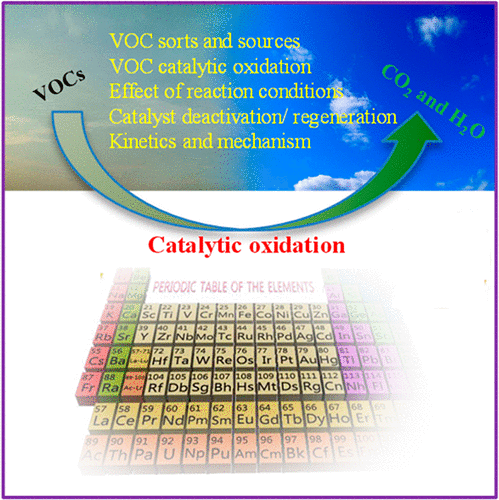当前位置:
X-MOL 学术
›
Chem. Rev.
›
论文详情
Our official English website, www.x-mol.net, welcomes your
feedback! (Note: you will need to create a separate account there.)
Recent Advances in the Catalytic Oxidation of Volatile Organic Compounds: A Review Based on Pollutant Sorts and Sources.
Chemical Reviews ( IF 51.4 ) Pub Date : 2019-02-27 , DOI: 10.1021/acs.chemrev.8b00408 Chi He 1, 2, 3 , Jie Cheng 1 , Xin Zhang 1 , Mark Douthwaite 3 , Samuel Pattisson 3 , Zhengping Hao 1
Chemical Reviews ( IF 51.4 ) Pub Date : 2019-02-27 , DOI: 10.1021/acs.chemrev.8b00408 Chi He 1, 2, 3 , Jie Cheng 1 , Xin Zhang 1 , Mark Douthwaite 3 , Samuel Pattisson 3 , Zhengping Hao 1
Affiliation

|
It is well known that urbanization and industrialization have resulted in the rapidly increasing emissions of volatile organic compounds (VOCs), which are a major contributor to the formation of secondary pollutants (e.g., tropospheric ozone, PAN (peroxyacetyl nitrate), and secondary organic aerosols) and photochemical smog. The emission of these pollutants has led to a large decline in air quality in numerous regions around the world, which has ultimately led to concerns regarding their impact on human health and general well-being. Catalytic oxidation is regarded as one of the most promising strategies for VOC removal from industrial waste streams. This Review systematically documents the progresses and developments made in the understanding and design of heterogeneous catalysts for VOC oxidation over the past two decades. It addresses in detail how catalytic performance is often drastically affected by the pollutant sources and reaction conditions. It also highlights the primary routes for catalyst deactivation and discusses protocols for their subsequent reactivation. Kinetic models and proposed oxidation mechanisms for representative VOCs are also provided. Typical catalytic reactors and oxidizers for industrial VOC destruction are further discussed. We believe that this Review will provide a great foundation and reference point for future design and development in this field.
中文翻译:

挥发性有机化合物催化氧化的最新进展:基于污染物种类和来源的综述。
众所周知,城市化和工业化导致挥发性有机化合物(VOC)的排放迅速增加,而挥发性有机化合物(VOCs)是形成二次污染物(例如对流层臭氧,PAN(过氧乙酰硝酸)和二次有机气溶胶)的主要因素。 )和光化学烟雾。这些污染物的排放已导致世界许多地区的空气质量大幅下降,最终导致人们对其污染物对人类健康和总体福祉的影响表示关注。催化氧化被认为是从工业废水中去除VOC的最有前景的策略之一。本综述系统地记录了过去二十年来在了解和设计用于VOC氧化的非均相催化剂方面的进展和进展。它详细介绍了催化性能通常如何受到污染物源和反应条件的严重影响。它还重点介绍了催化剂失活的主要途径,并讨论了其后续再活化的方案。还提供了代表性VOC的动力学模型和拟议的氧化机理。进一步讨论了用于工业VOC破坏的典型催化反应器和氧化剂。我们认为,本审查将为该领域的未来设计和开发提供良好的基础和参考点。还提供了代表性VOC的动力学模型和拟议的氧化机理。进一步讨论了用于工业VOC破坏的典型催化反应器和氧化剂。我们认为,本审查将为该领域的未来设计和开发提供良好的基础和参考点。还提供了代表性VOC的动力学模型和拟议的氧化机理。进一步讨论了用于工业VOC破坏的典型催化反应器和氧化剂。我们认为,本审查将为该领域的未来设计和开发提供一个很好的基础和参考点。
更新日期:2019-02-27
中文翻译:

挥发性有机化合物催化氧化的最新进展:基于污染物种类和来源的综述。
众所周知,城市化和工业化导致挥发性有机化合物(VOC)的排放迅速增加,而挥发性有机化合物(VOCs)是形成二次污染物(例如对流层臭氧,PAN(过氧乙酰硝酸)和二次有机气溶胶)的主要因素。 )和光化学烟雾。这些污染物的排放已导致世界许多地区的空气质量大幅下降,最终导致人们对其污染物对人类健康和总体福祉的影响表示关注。催化氧化被认为是从工业废水中去除VOC的最有前景的策略之一。本综述系统地记录了过去二十年来在了解和设计用于VOC氧化的非均相催化剂方面的进展和进展。它详细介绍了催化性能通常如何受到污染物源和反应条件的严重影响。它还重点介绍了催化剂失活的主要途径,并讨论了其后续再活化的方案。还提供了代表性VOC的动力学模型和拟议的氧化机理。进一步讨论了用于工业VOC破坏的典型催化反应器和氧化剂。我们认为,本审查将为该领域的未来设计和开发提供良好的基础和参考点。还提供了代表性VOC的动力学模型和拟议的氧化机理。进一步讨论了用于工业VOC破坏的典型催化反应器和氧化剂。我们认为,本审查将为该领域的未来设计和开发提供良好的基础和参考点。还提供了代表性VOC的动力学模型和拟议的氧化机理。进一步讨论了用于工业VOC破坏的典型催化反应器和氧化剂。我们认为,本审查将为该领域的未来设计和开发提供一个很好的基础和参考点。





















































 京公网安备 11010802027423号
京公网安备 11010802027423号